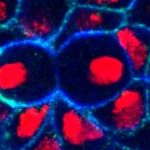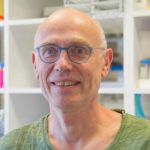Link to Pubmed [PMID] – 7590238
Genes Dev. 1995 Nov;9(21):2598-608
The Notch protein (N) acts as a transmembrane receptor for intercellular signals controlling cell fate choices in vertebrates and invertebrates. The signal of N activation may be transduced directly from the cell surface into the nucleus by an evolutionarily conserved transcription factor, Suppressor of Hairless [Su(H)], by its regulated nuclear import. Su(H) is shown here to play a direct role in the immediate response of the genome to N signaling in Drosophila. First, Su(H) mutant embryos derived from mutant germ-line clones exhibited a “neurogenic” phenotype of neural hypertrophy similar to the N phenotype. Second, the lack of N lateral signaling in these Su(H) mutant embryos was associated with a failure to express the m5 and m8 genes from the Enhancer of split Complex [E(spl)-C]. Finally, the Su(H) protein bound to the regulatory sequences of the E(spl)-C m5 and m8 genes, and these binding sites were required for the activation of the m5 and m8 promoters in the ventral neuroectoderm. The expression of the E(spl)-C m8 gene was found to be similarly regulated by Su(H) during wing imaginal disc development. Thus, the transcriptional activation of these E(spl)-C genes by Su(H) appears to be a direct and relatively general response to the activation of N. However, we also present evidence indicating that N signals in an Su(H)-independent manner during mesectoderm formation.

